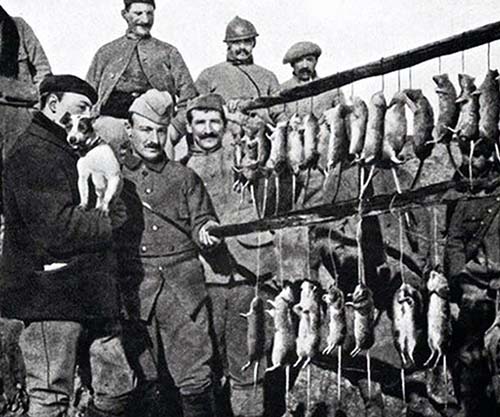Rats were an alarming and pervasive problem in the trenches during WWI, significantly affecting the daily lives and morale of soldiers. The harsh and unsanitary conditions of trench warfare provided an ideal environment for rats to thrive. These pests were not merely a nuisance but a serious health hazard, symbolising the dreadful living conditions soldiers faced.
The Problem with Rats
The trench environment was perfect for rats, with ample food sources from discarded scraps and the bodies of fallen soldiers. The rats grew to an unusually large size due to the abundance of food, sometimes reaching lengths of over a foot. Their presence was a constant source of discomfort and fear for the soldiers, who often found these rats in their sleeping areas and even on their bodies while they slept.
Rats were notorious for scavenging the dead, including the bodies of soldiers who had fallen in battle. In some cases, they would even attack living soldiers, gnawing on their flesh and causing severe distress. The sheer number and size of these rats turned them into one of the many grim realities of trench life, contributing to the overall degradation of soldiers' living conditions.

Health Issues Related to Rats
The health risks posed by rats were significant. They were carriers of diseases such as typhus and leptospirosis, transmitted through their fleas and urine. The presence of rats exacerbated the already poor sanitary conditions in the trenches, increasing the likelihood of disease outbreaks among soldiers.
The combination of unsanitary living conditions and disease-carrying rats created a hazardous environment that impacted the health and morale of the troops. Soldiers had to contend not only with the physical discomfort of rat infestations but also with the psychological toll of living in such grim conditions.
Measures Taken to Deal with Rats
Efforts to control the rat population included setting traps and using poison. Soldiers would attempt to keep their living quarters as clean as possible, but these measures often proved insufficient due to the sheer number of rats and the persistent nature of the infestations. Despite their efforts, rats remained a major problem throughout the war.
The challenge of managing rat infestations highlighted the broader difficulties in maintaining hygiene and health in the trenches. The constant battle against these pests was just one of many hardships faced by soldiers on the Western Front.
Conclusion
The problem of rats in the trenches was a stark reminder of the harsh and unsanitary conditions experienced by soldiers during World War I. The presence of these pests not only added to the physical discomfort but also symbolised the overall degradation of trench life. Understanding the impact of rats on soldiers provides insight into the broader challenges of trench warfare and the relentless struggle for survival faced by those on the front lines.
